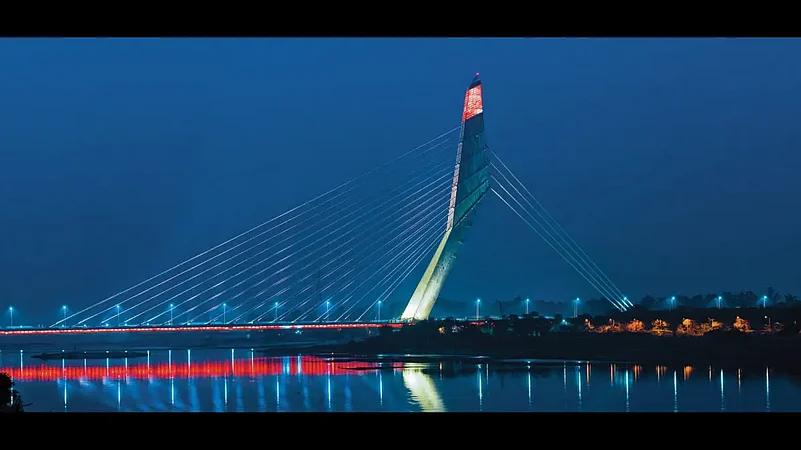Of the many tributaries and streams that join the Ganga, it is probably Yamuna that is the most significant. Not only is it extremely important to more than one religion, it also drains nearly 40% of the Ganga’s basin—Chambal, Betwa, Tons and Ken being some of Yamuna’s own tributaries. Almost 57 million people depend on the Yamuna for survival, and some of India’s most densely populated cities lie on the river’s banks—Delhi, Prayagraj, Agra and Mathura being a few of them.
The Yamuna enters Delhi near Wazirabad, then passes through the city for 22 kilometres before making its exit. The Yamuna Biodiversity Park is located right where the river enters Delhi. As a wetland, its value cannot be stressed upon enough. Spread over 9,770 hectares, the park plays an important role in replenishing Delhi’s supply of groundwater, especially during the lean periods. Above all, it is home to nearly 2,000 different species of plants and between 5,000 and 7,000 different species of migratory birds from around the world. It remains one of Delhi’s 237 existing wetlands that plays such a vital role in ensuring the sustenance of people and maintaining the ecological balance all around.
Advertisement

Today, however, the river is in dire straits in the National Capital Region. There are many reasons for Yamuna’s pollution: release of industrial effluents, household and municipal sewage and solid waste discharge, deforestation are a few of the critical ones.
Under the National Mission for Clean Ganga (NMCG), however, significant progress has been made to clean the Yamuna. The NMCG along with the Delhi Jal Board (DJB) has taken up work on building and upgrading 13 sewage treatment plants (STPs) throughout the length and the breadth of the city. The one at Okhla will have a capacity of treating 565 million litres daily (MLD) of sewage—the largest of its kind in India. Overall, the 13 plants, costing around ₹2,354 crore, will treat 1384.5 MLD of sewage in Delhi—a necessary intervention if the river is to be cleaned up in India’s capital city. Furthermore, Ganga Praharis and volunteers, both young and old, have taken up the baton of cleaning up the banks of the Yamuna at various points along its course in Delhi. To this end, Tree Craze Foundation, a not-for-profit, was able to recruit over a million young and willing participants through the Meri Yamuna, Mere Ghat programme to aid in these clean-up drives.
Advertisement
For centuries, the river has not just sustained Delhi’s population, many of the city’s famed monuments and spaces have also been nurtured by the river—Red Fort, Humayan’s Tomb and the area now known as Sunder Nursery are only a few of these. The river once flowed close to these beautiful monuments, and supplied hygienic water to the complexes that contain these monuments for use by their residents. The times may have changed, but looking at these monuments, nurseries and gardens remarkably restored and maintained by organisations and institutions such as the Archaeological Society of India (ASI) and the Aga Khan Trust for Culture today, one can well imagine how central a role Yamuna must have played in the creation of these sublime architectural constructions.
***
This sense of a city’s heritage being moulded by a river can also be seen in the ancient city of Mathura—a place sacred because of the twin presences of Yamuna and Lord Krishna. There are as many as 25 bathing ghats along the Yamuna here. The most famous of these, the Vishram Ghat, is dedicated to Lord Krishna—it is said that Krishna retired to this ghat after defeating his uncle, Kamsa.

For a city so dependent on Yamuna for livelihood and tourism, it is only to be expected that the river needs to be protected in Mathura. Two STPs with a capacity of 37 MLD operate and are expected to soon be upgraded. A third STP with a capacity of 30 MLD is also being constructed and slated to open to further boost the river conservation efforts. In addition to these, a tertiary treatment plant (TTP) with a 20 MLD capacity aids these efforts in a unique way. This plant happens to be India’s first ‘recycle reuse project’ under the Namami Gange programme. The treated, reusable water is then sent for use to the Indian Oil refinery in the city. This intervention helps stop the wastage of water resources in a major way, leading to its conservation.
Advertisement
***
Both Mathura and Delhi continue to be significant, from a religious perspective, even in the 21st century. There’s an important lesson to be learnt from the plight of the Yamuna and the river-conservation efforts in both cities. If we remain so steadfast in our religious beliefs and care about them so fervently, there should ideally be no conceivable reason why we should neglect the very river that sustains them. Yet, the state of the Yamuna says otherwise—and it is this callous, irreverent attitude of ours that needs to change. After all, saving the Yamuna requires behavioural changes regarding water usage on the part of the inhabitants of the cities as much as it requires the dedicated efforts of the Namami Gange authorities.




















